Woodworking materials are the heart and soul of any project, from intricate furniture to simple crafts. Understanding the different types of wood, their properties, and how to work with them is essential for creating beautiful and durable pieces. Whether you’re a seasoned woodworker or just starting out, this guide will equip you with the knowledge and skills needed to select the right materials for your next woodworking endeavor.
From hardwoods to softwoods, engineered woods, and plywood, each material possesses unique characteristics that influence its suitability for specific applications. This guide will explore the properties of various woodworking materials, provide insights into their selection, and delve into practical techniques for working with them.
Types of Woodworking Materials
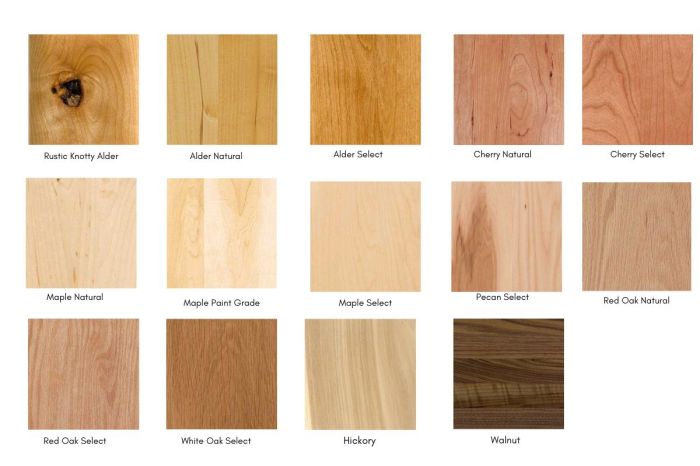
Woodworking materials encompass a wide array of options, each with unique properties and applications. Understanding the characteristics of different wood types is crucial for selecting the right material for your woodworking project.
Hardwoods
Hardwoods are derived from deciduous trees, which lose their leaves seasonally. They are generally denser and harder than softwoods, offering greater durability and strength.
- Oak: Renowned for its strength, durability, and beautiful grain patterns. Widely used in furniture, flooring, and cabinetry.
- Maple: Known for its hardness, smooth surface, and light color. Popular for furniture, cutting boards, and musical instruments.
- Cherry: Characterized by its rich reddish-brown color and fine grain. Often used for furniture, cabinetry, and decorative items.
- Walnut: Highly prized for its rich brown color, distinctive grain patterns, and durability. Used in high-end furniture, veneers, and gunstocks.
- Mahogany: Known for its reddish-brown color, durability, and resistance to decay. Widely used for furniture, boat building, and musical instruments.
Softwoods
Softwoods are derived from coniferous trees, which bear cones and retain their leaves year-round. They are generally softer and less dense than hardwoods, making them easier to work with.
- Pine: A common and affordable softwood with a distinctive knotty grain. Used for construction, furniture, and craft projects.
- Cedar: Known for its aromatic fragrance, natural resistance to decay, and light color. Used for outdoor furniture, siding, and closets.
- Fir: A strong and durable softwood with a straight grain. Used for construction, framing, and furniture.
- Spruce: A lightweight and versatile softwood with a straight grain. Used for construction, musical instruments, and plywood.
Engineered Woods
Engineered woods are manufactured wood products created by combining wood fibers, veneers, or other wood byproducts. They offer consistent properties and are often more affordable than solid wood.
- Plywood: Composed of thin layers of wood veneer glued together with alternating grain directions. Offers stability, strength, and affordability. Widely used in construction, furniture, and marine applications.
- Medium-density Fiberboard (MDF): Made from wood fibers that are broken down, mixed with resin, and pressed into sheets. Offers a smooth, consistent surface and is easy to work with. Used for furniture, cabinets, and molding.
- Oriented Strand Board (OSB): Made from wood strands that are glued together and pressed into sheets. Offers strength and affordability. Primarily used in construction for sheathing and subflooring.
Other Woodworking Materials
- Veneer: Thin sheets of wood used for decorative purposes, such as laminating furniture or creating intricate patterns.
- Particleboard: Made from wood chips or sawdust that are glued together and pressed into sheets. Offers affordability and is used for furniture, cabinets, and shelving.
- Bamboo: A fast-growing grass that is becoming increasingly popular as a sustainable and durable woodworking material. Used for flooring, furniture, and construction.
Woodworking Material Selection
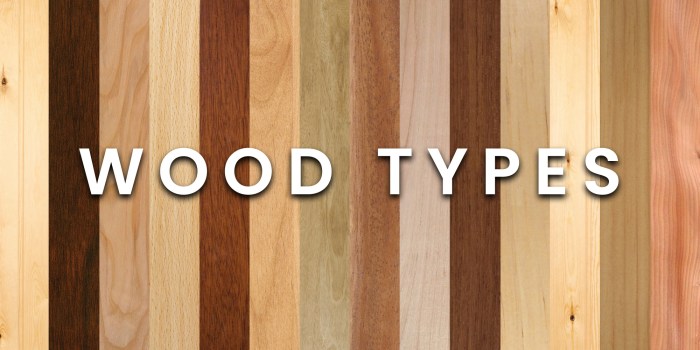
Choosing the right materials for your woodworking project is crucial for achieving the desired results and ensuring the longevity of your creation. A well-informed selection process takes into account various factors, ensuring that your project meets both functional and aesthetic expectations.
Factors to Consider
Selecting the right wood for your project is crucial, and a number of factors should be taken into account.
- Intended Use: The purpose of your project will dictate the type of wood you choose. For example, furniture that will receive heavy use requires durable hardwoods like oak or maple, while a delicate decorative piece might be better suited for softer woods like pine or cedar.
- Desired Aesthetics: Wood comes in a wide range of colors, grain patterns, and textures. Consider the overall aesthetic you want to achieve and choose a wood that complements your design. For example, cherry wood is known for its rich red tones, while walnut is prized for its distinctive dark grain.
- Budget Constraints: Wood prices vary widely depending on species, quality, and availability. Set a realistic budget and choose materials that fit within your financial constraints. Consider sourcing wood from local suppliers or using reclaimed wood to potentially reduce costs.
- Availability: Some wood species are more readily available than others, depending on your location and the time of year. Research local suppliers and consider the availability of the wood you want to use before committing to a particular project.
Advantages and Disadvantages of Different Wood Materials
- Hardwoods: Known for their strength, durability, and beautiful grain patterns, hardwoods are commonly used for furniture, cabinetry, and flooring. Examples include oak, maple, cherry, walnut, and mahogany.
- Advantages: Strong, durable, beautiful grain patterns, resistant to scratches and dents.
- Disadvantages: More expensive than softwoods, can be difficult to work with, susceptible to moisture changes.
- Softwoods: Typically lighter and less expensive than hardwoods, softwoods are often used for construction, trim, and crafts. Examples include pine, fir, cedar, and spruce.
- Advantages: Easy to work with, less expensive than hardwoods, readily available.
- Disadvantages: Not as strong or durable as hardwoods, prone to scratches and dents, can be susceptible to moisture damage.
- Engineered Woods: Made from wood veneers, fibers, or particles bonded together with adhesives, engineered woods offer a cost-effective and consistent alternative to solid wood. Examples include plywood, MDF (medium-density fiberboard), and OSB (oriented strand board).
- Advantages: Stable and consistent, less expensive than solid wood, available in large sheets, less prone to warping or cracking.
- Disadvantages: Not as strong or durable as solid wood, can be susceptible to moisture damage, may not have the same aesthetic appeal as solid wood.
Material Selection Guide for Different Woodworking Projects
Here is a guide outlining ideal material choices for different woodworking projects, taking into account the factors discussed above.
- Furniture: For furniture that will receive heavy use, hardwoods like oak, maple, cherry, or walnut are recommended. For lighter-duty furniture, softwoods like pine or cedar can be used. Engineered woods like plywood or MDF can also be used for furniture construction, but may not be as durable as solid wood. Consider the style and intended use of the furniture when selecting materials.
- Cabinetry: Cabinetry requires durable and moisture-resistant materials. Hardwoods like oak, maple, or cherry are excellent choices for cabinetry, offering both beauty and longevity. Engineered woods like plywood or MDF can also be used for cabinetry, but they may not be as durable as solid wood and are less resistant to moisture damage.
- Outdoor Structures: Outdoor structures should be made from weather-resistant materials. Hardwoods like cedar, redwood, or teak are naturally resistant to decay and insects. Pressure-treated pine or spruce can also be used for outdoor structures, but they require regular maintenance to prevent decay and insect damage. Engineered woods like plywood or OSB are not recommended for outdoor structures, as they are not as durable as solid wood and are more susceptible to moisture damage.
- Decorative Projects: For decorative projects, the choice of wood is largely determined by aesthetic preference. Softwoods like pine or cedar can be used for decorative projects, as they are easy to work with and can be stained or painted to achieve different looks. Hardwoods like cherry, walnut, or mahogany can also be used for decorative projects, adding a touch of elegance and sophistication. Engineered woods like plywood or MDF can be used for decorative projects, but they may not have the same aesthetic appeal as solid wood.
Working with Woodworking Materials
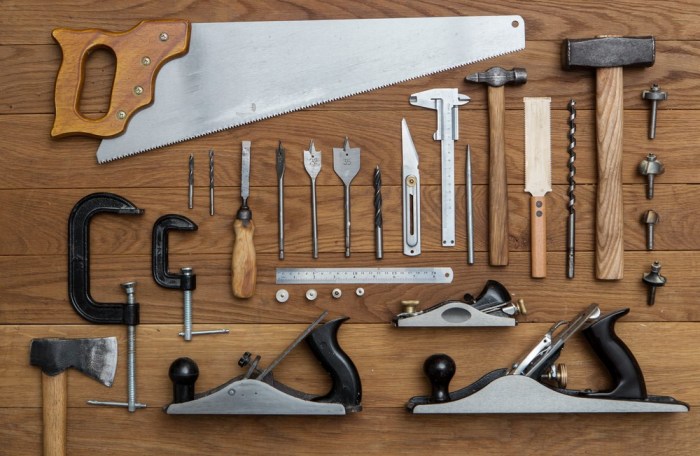
Now that you have a grasp of the different woodworking materials and how to select the right one for your project, let’s dive into the practical side of working with these materials. This section will guide you through common woodworking techniques and the tools you’ll need, ensuring a safe and successful woodworking journey.
Cutting Woodworking Materials
Cutting is a fundamental step in woodworking, and the techniques you employ will depend on the material and the desired shape. Here’s a breakdown of common cutting methods:
- Hand Saws: These versatile tools are perfect for making straight cuts and are ideal for intricate work where a power saw might be too bulky. Common hand saws include crosscut saws for cutting across the grain, ripsaws for cutting with the grain, and backsaws for precise cuts.
- Power Saws: For larger projects or faster cutting, power saws are indispensable. Circular saws provide precise cuts and are excellent for ripping and crosscutting. Table saws offer greater accuracy and stability, making them ideal for repetitive cuts and shaping. Jigsaws are used for intricate cuts, while miter saws provide accurate angled cuts.
- Chisels and Gouges: These hand tools are essential for shaping and carving wood. Chisels are used for removing material in straight lines, while gouges are ideal for curved cuts and shaping.
- Router: Routers are powerful tools used for creating intricate shapes, edges, and profiles. They are versatile and can be used with various bits to achieve different effects.
Safety Precautions:
* Always wear safety glasses and hearing protection when using power tools.
* Use a push stick or featherboard to keep your fingers away from the blade.
* Ensure the blade is sharp and properly secured.
* Keep your work area clean and free of clutter.
Shaping Woodworking Materials
Shaping is the process of creating a desired form for your woodworking project. It involves techniques that remove material to create curves, edges, and other details.
- Hand Planes: These tools are used to smooth and flatten wood surfaces. They are particularly useful for creating subtle curves and shaping edges.
- Sanding: Sanding is essential for achieving a smooth finish on your woodworking projects. It involves using sandpaper to remove imperfections and create a consistent surface. Sanding can be done by hand or with a power sander, depending on the desired level of detail and the size of the project.
- Carving: Carving is a more intricate shaping technique that involves using hand tools to create detailed designs and patterns. This requires patience and skill and is often used for decorative elements and functional details.
Safety Precautions:
* Always wear a dust mask when sanding to protect your lungs from wood dust.
* Use caution when using power sanders to avoid injury.
* Ensure your tools are sharp and in good working condition.
Finishing Woodworking Materials
Finishing is the final step in the woodworking process and involves protecting and enhancing the wood’s natural beauty.
- Staining: Stains are used to color the wood without hiding its grain. They come in various colors and finishes, allowing you to customize the look of your project.
- Varnishing: Varnish is a clear protective coating that seals and protects the wood from scratches, moisture, and UV damage. It also enhances the wood’s natural beauty and adds a glossy finish.
- Painting: Paint is used to cover the wood entirely, offering a wide range of colors and finishes. It can be used for both functional and decorative purposes.
- Waxes: Waxes provide a protective layer and enhance the wood’s natural sheen. They are often used as a final finish for a more natural look.
Safety Precautions:
* Always work in a well-ventilated area when applying finishes.
* Wear gloves and a respirator to protect your skin and lungs.
* Store finishes in a safe location away from children and pets.
Simple Woodworking Project: A Wooden Shelf
This step-by-step guide will walk you through building a simple wooden shelf, demonstrating the techniques and considerations discussed earlier.
Materials:
* Wood boards (length and width depending on your desired shelf size)
* Wood glue
* Screws
* Wood stain (optional)
* Varnish (optional)
* Sandpaper
Tools:
* Measuring tape
* Pencil
* Hand saw or circular saw
* Drill
* Screwdriver
* Clamps
* Sandpaper
Steps:
1. Measure and Cut: Using a measuring tape and pencil, mark the desired lengths for your shelf boards. Cut the boards to size using a hand saw or circular saw.
2. Sand the Edges: Sand the edges of the boards to create a smooth surface. Use a fine-grit sandpaper for a smooth finish.
3. Assemble the Shelf: Glue and screw the shelf boards together to form the shelf. Use clamps to secure the boards while the glue dries.
4. Sand the Shelf: Once the glue has dried, sand the entire surface of the shelf to create a smooth and even finish.
5. Apply Stain (Optional): If desired, apply a wood stain to the shelf. Let the stain dry completely before proceeding to the next step.
6. Apply Varnish (Optional): To protect the shelf and enhance its appearance, apply a coat of varnish. Let the varnish dry completely before using the shelf.
Considerations:
* When choosing wood for your shelf, consider the weight it will need to support. Hardwoods like oak and maple are strong and durable, while softer woods like pine are lighter but may require additional support.
* Use wood glue and screws to ensure a strong and secure connection between the shelf boards.
* Apply varnish in thin coats to avoid dripping and uneven coverage.
* Allow each coat of finish to dry completely before applying the next.
Woodworking Material Sustainability

Woodworking, a craft deeply intertwined with nature, has a significant impact on the environment. The materials we use, the processes we employ, and the choices we make all contribute to the sustainability of our craft.
Environmental Impact of Woodworking Materials
The environmental impact of woodworking materials is multifaceted and requires careful consideration. Deforestation, carbon footprint, and resource depletion are some of the key factors to consider.
- Deforestation: The extraction of wood for woodworking can lead to deforestation, which has a devastating impact on ecosystems, biodiversity, and climate change. The loss of forests disrupts natural carbon cycles, reduces rainfall, and increases soil erosion. It also threatens the habitats of countless species, impacting biodiversity.
- Carbon Footprint: Wood is a renewable resource, but its production and processing still contribute to carbon emissions. The harvesting, transportation, and manufacturing of wood products release greenhouse gases, adding to our carbon footprint. The carbon footprint of wood can vary significantly depending on the source, processing methods, and transportation distances.
- Resource Depletion: The overuse of certain wood species for woodworking can lead to resource depletion, particularly for valuable hardwoods. This can create imbalances in forest ecosystems and threaten the long-term availability of these materials.
Sustainable Woodworking Practices and Materials
Fortunately, there are numerous sustainable woodworking practices and materials that minimize environmental impact.
- Reclaimed Wood: Using reclaimed wood, salvaged from old buildings, furniture, or other structures, significantly reduces the demand for newly harvested wood. Reclaimed wood offers unique character and history, making it a desirable choice for many woodworking projects. The process of reclaiming wood often involves cleaning, drying, and re-milling, which can add to the overall cost but contributes to a sustainable woodworking approach.
- Bamboo: Bamboo is a fast-growing, renewable resource that offers an excellent alternative to traditional hardwoods. It has a high strength-to-weight ratio, making it suitable for a wide range of woodworking applications. Bamboo’s rapid growth cycle and ability to regenerate quickly contribute to its sustainability. However, it is important to source bamboo from sustainably managed forests and ensure responsible harvesting practices. It’s worth noting that bamboo is not technically a wood, but a grass. While it’s used in woodworking, its unique properties and growth patterns make it a distinct and sustainable alternative.
- Certified Sustainable Forestry: Choosing wood from certified sustainable forests ensures that the timber comes from responsibly managed forests. Certifications like the Forest Stewardship Council (FSC) and the Sustainable Forestry Initiative (SFI) guarantee that the wood is harvested in a way that maintains forest health, biodiversity, and ecological integrity. These certifications promote sustainable forestry practices, such as reforestation, biodiversity conservation, and responsible land management. When purchasing wood, look for these certifications to ensure that you are supporting sustainable forestry practices.
Tips for Reducing Waste and Promoting Eco-Friendly Woodworking Practices
Reducing waste and adopting eco-friendly woodworking practices is essential for minimizing the environmental impact of our craft.
- Plan and Cut Efficiently: Careful planning and precise cutting techniques can minimize waste. Utilize scrap wood for smaller projects or for creating decorative elements. Consider using templates and jigs to ensure accurate cuts and reduce the need for rework. By planning ahead and making precise cuts, you can maximize material utilization and minimize waste.
- Use Recycled Materials: Incorporate recycled materials into your woodworking projects whenever possible. This can include reclaimed wood, repurposed furniture, or salvaged materials from other sources. Recycled materials often add character and uniqueness to projects, while reducing the demand for new resources. For example, you could use recycled plastic for decorative elements or repurposed metal for hardware.
- Proper Tool Maintenance: Sharp tools and well-maintained equipment make for cleaner cuts and less waste. Regularly sharpening blades and ensuring that tools are in good working order can improve efficiency and reduce material waste. A sharp blade, for instance, can create cleaner cuts, resulting in less waste and a smoother finish.
- Reduce Dust and Emissions: Proper dust collection systems and ventilation can minimize dust and airborne emissions generated during woodworking. Use dust masks and other personal protective equipment to protect yourself from dust inhalation. Investing in a dust collector or using a well-ventilated workshop can help reduce the environmental impact of dust and emissions. Regularly cleaning your workshop and disposing of dust properly are also essential for maintaining a healthy and sustainable woodworking environment.
Woodworking Material Finishes
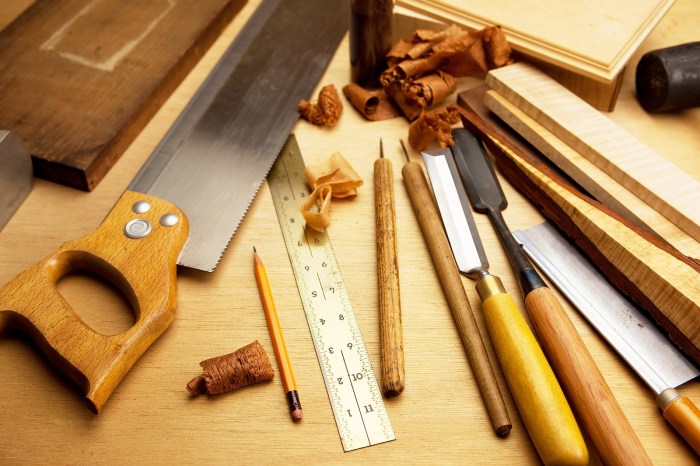
Giving your woodworking projects a beautiful and durable finish is a crucial step that enhances their appearance, protects the wood, and increases their lifespan. Choosing the right finish depends on the type of wood, the project’s intended use, and your personal preferences.
Types of Woodworking Finishes
Wood finishes are typically categorized into four main types: paints, stains, varnishes, and oils. Each type offers unique properties and applications, making it essential to understand their characteristics to choose the best option for your woodworking project.
- Paints: Paints are opaque coatings that completely cover the wood’s natural grain and color. They are available in a wide range of colors and finishes, from matte to gloss, and can be used to create a variety of effects. Paints are known for their durability and ease of application, making them suitable for both indoor and outdoor projects. They can also be used to hide imperfections in the wood.
- Stains: Stains are semi-transparent coatings that penetrate the wood’s surface, enhancing its natural grain and color. They are available in a wide range of colors, from light to dark, and can be used to create a variety of effects. Stains are generally less durable than paints but offer a more natural look. They are often used for furniture, cabinets, and other indoor projects.
- Varnishes: Varnishes are clear coatings that protect the wood’s surface from scratches, moisture, and UV damage. They are available in a variety of finishes, from matte to gloss, and can be used to create a variety of effects. Varnishes are known for their durability and water resistance, making them suitable for both indoor and outdoor projects. They can also be used to enhance the wood’s natural beauty.
- Oils: Oils are natural finishes that penetrate the wood’s surface, providing a protective layer. They are available in a variety of types, including linseed oil, tung oil, and Danish oil. Oils are known for their natural look and feel, and they can be used to enhance the wood’s natural beauty. They are often used for furniture, cutting boards, and other indoor projects.
Comparing and Contrasting Woodworking Finishes, Woodworking materials
When choosing a woodworking finish, it is essential to consider factors like durability, aesthetics, ease of application, and environmental impact. Each finish has its own advantages and disadvantages, making it important to weigh these factors carefully.
Durability
- Paints: Paints are generally the most durable finish, offering excellent protection against scratches, moisture, and UV damage. They are also easy to clean and maintain, making them a good choice for high-traffic areas.
- Varnishes: Varnishes are also very durable, offering excellent protection against scratches, moisture, and UV damage. They are a good choice for projects that will be exposed to the elements, such as outdoor furniture and decks.
- Stains: Stains are less durable than paints and varnishes, but they still offer some protection against scratches and moisture. They are a good choice for projects that will not be exposed to heavy wear and tear.
- Oils: Oils are the least durable finish, offering minimal protection against scratches and moisture. They are best suited for projects that will not be exposed to heavy wear and tear, such as furniture and cutting boards.
Aesthetics
- Paints: Paints offer the most versatility in terms of aesthetics, allowing you to create a wide range of effects, from solid colors to patterned designs. They can also be used to create a variety of finishes, from matte to gloss.
- Stains: Stains enhance the wood’s natural beauty, allowing its grain and color to show through. They are often used to create a more natural look.
- Varnishes: Varnishes are clear coatings that protect the wood’s surface without obscuring its natural beauty. They can be used to create a variety of finishes, from matte to gloss.
- Oils: Oils enhance the wood’s natural beauty, providing a rich, warm look. They are often used to create a more natural look.
Ease of Application
- Paints: Paints are generally easy to apply, and they can be applied with a brush, roller, or spray gun. They also dry quickly, making them a good choice for projects that need to be finished quickly.
- Stains: Stains are also relatively easy to apply, but they require more care to ensure an even finish. They can be applied with a brush, cloth, or spray gun.
- Varnishes: Varnishes are more difficult to apply than paints and stains, as they require more care to avoid brush strokes and other imperfections. They can be applied with a brush, cloth, or spray gun.
- Oils: Oils are generally easy to apply, but they require more care to ensure an even finish. They can be applied with a brush, cloth, or spray gun.
Environmental Impact
- Paints: Paints can have a significant environmental impact, as they often contain volatile organic compounds (VOCs) that can contribute to air pollution. However, there are now many low-VOC paints available that are safer for the environment.
- Stains: Stains are generally less harmful to the environment than paints, as they contain fewer VOCs. However, some stains may contain chemicals that can be harmful to the environment.
- Varnishes: Varnishes can also have a significant environmental impact, as they often contain VOCs. However, there are now many low-VOC varnishes available that are safer for the environment.
- Oils: Oils are generally considered to be a more environmentally friendly option than paints and varnishes, as they are made from natural ingredients. However, some oils may contain chemicals that can be harmful to the environment.
Woodworking Finish Recommendations
| Finish | Characteristics | Recommended Uses |
|---|---|---|
| Paint | Durable, opaque, wide range of colors and finishes | Outdoor furniture, doors, windows, cabinets, walls |
| Stain | Semi-transparent, enhances wood’s natural beauty | Furniture, cabinets, floors, trim |
| Varnish | Clear, durable, protects against scratches and moisture | Outdoor furniture, decks, floors, boat hulls |
| Oil | Natural, enhances wood’s natural beauty, provides a protective layer | Furniture, cutting boards, butcher block countertops |
Last Word
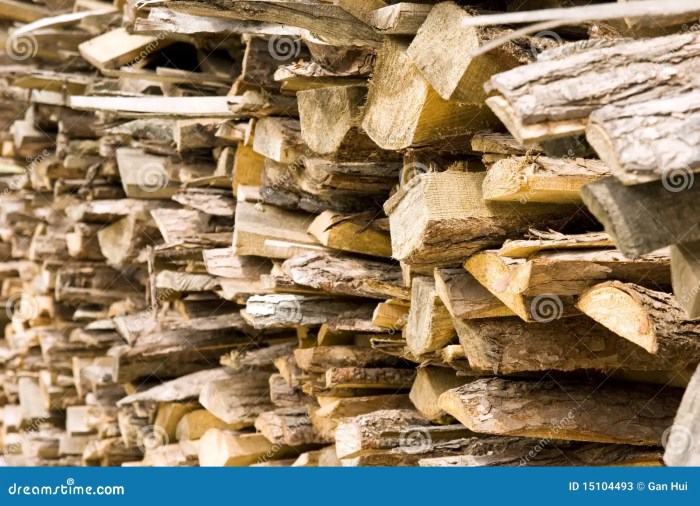
By understanding the intricacies of woodworking materials, you can unleash your creativity and craft projects that stand the test of time. From selecting the right wood to mastering the art of finishing, this guide empowers you to navigate the world of woodworking with confidence and expertise. So, pick up your tools, embrace the beauty of wood, and embark on a journey of woodworking excellence.
FAQ Section
What are the most common types of wood used in woodworking?
The most common types of wood used in woodworking include hardwoods like oak, maple, cherry, and walnut, and softwoods like pine, fir, and cedar.
How do I choose the right wood for my project?
Consider factors like the project’s intended use, desired aesthetics, budget constraints, and the wood’s availability. For example, hardwoods are generally more durable and aesthetically pleasing but also more expensive.
What are some sustainable woodworking practices?
Use reclaimed wood, bamboo, or certified sustainable forestry products. Reduce waste by utilizing scraps and using woodworking techniques that minimize material loss.
Woodworking materials are the building blocks of any project, from simple crafts to intricate furniture. Choosing the right wood for your project is crucial, as it affects the final look, durability, and even the tools you’ll need. If you’re looking for inspiration for your next woodworking project, check out this woodworking project website for some amazing ideas.
Once you’ve decided on your project, you can then select the appropriate materials to bring your vision to life.
